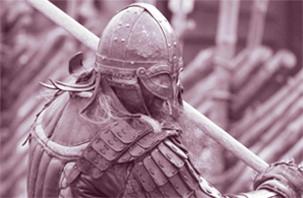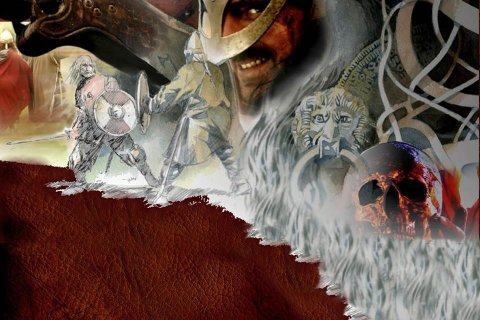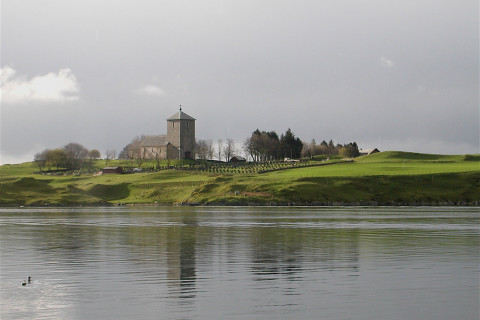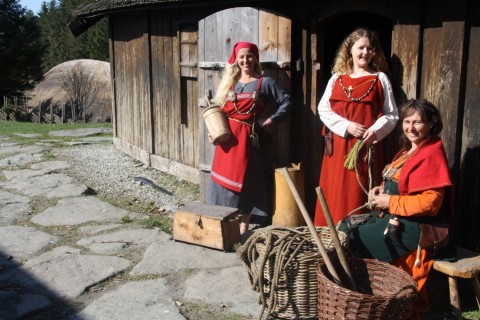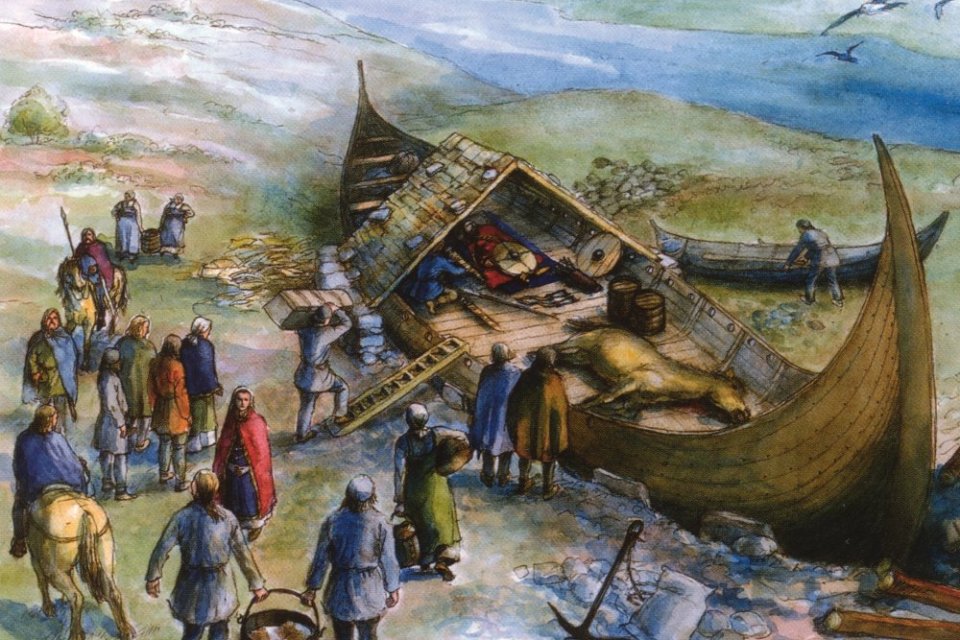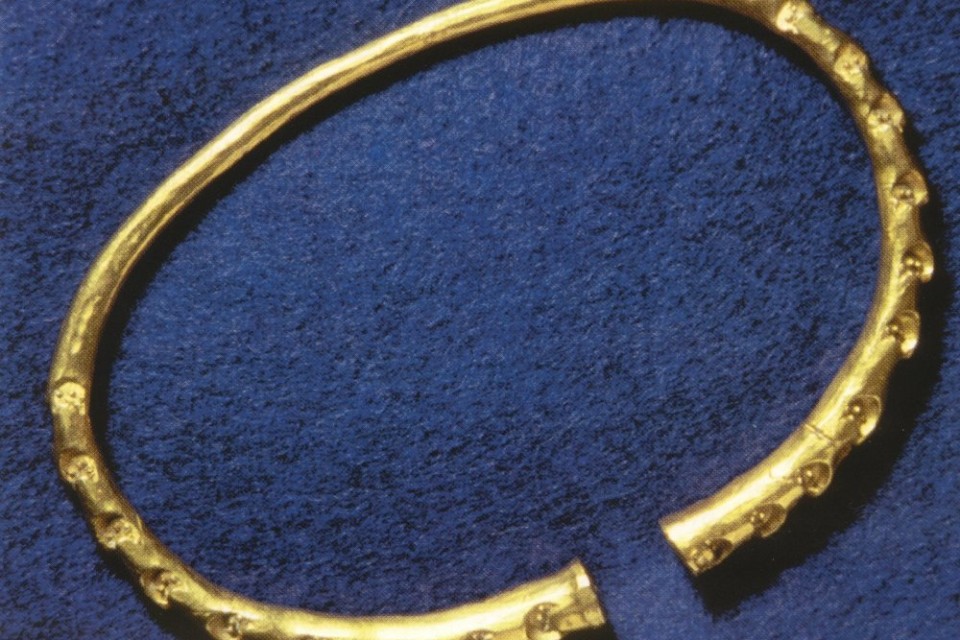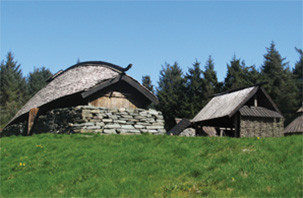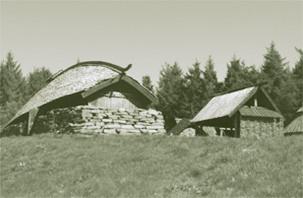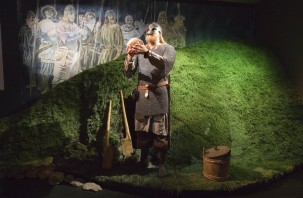Half
Text: Marit Synnøve Vea
King Half/Halv was the great great grandson of King Augvald. He probably lived some time during the 8th century. The name Half (Old Norse Halfr) is believed to come from ON há alfr = high elf. Others have suggested that the name is derived from the ancient Scandinavian word for war wolf (Haþuwulafr.)
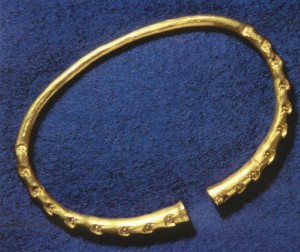
Armring og gold from the ship burial Storhaug. In Nornagests þáttr (Flateyarbok) we are told that Ulv the Red comes to King Olav Tryggvason with the ring Hnituðr that once belonged to King Halv:
“Ulf had brought the king much good treasure, which he had gained during the summer, and he had gotten a gold ring, which was named Hnitud. It was welded together in seven places, and each part had its own color. The gold was much better than other rings. A farmer named Lothmund had given it to Ulf. The ring had previously belonged to King Half, from whom the Halfsrekkar are descended and known.“
(Photo Bergen Museum)
It is first and foremost in the ancient Saga of Half & His Heroes that we read about Half the Viking hero who was certainly famous in his own time, but we also find traces of him in other Norse literature:
In the skaldic poem Ynglingatal (probably from around 900), Half’s death is used as a symbol for fire. (Half was burnt to death by his stepfather). This indicates that Half was still well known in the century following his death.
The Edda poem Hyndluljod says (depending on the particular translation we are reading) … and Hild gave birth to Halfr/Hild was Half’s mother/but the eldest brother was called (H)Alf. In the ancient poem Gudrunkvida (lay about Gudrun), we learn that Gudrun, grieving for the death of Sigurd Fåvnesbane, goes into the mountains: for five whole days until I could see Half’s high hall. In the Flatey Book, we find an account of the magnificent gold ring that Half apparently owned. The Faroese poem Alvur kongur (King Alf) is also about Half.
How Half chose the crew for his Viking raids
The Saga of Half & His Heroes relates that when Half was 12 years old, he was bigger and stronger than anyone else. He had a fine new ship and intended to go on a Viking raid, but he wanted to take only the very best of men with him. He therefore laid down strict conditions for those who were to be allowed onto the ship.
The first to be chosen was Innstein from Hordaland. Innstein’s son, Ottar, is the main character in the Edda poem Hyndluljod. Innstein was 18 years old and became Half’s counsellor; nobody younger than he was to go on the raid, apart from Half himself.
Back home at the manor, there was a large stone and only those who managed to lift this stone from the ground were included in the crew of the ship. Only those who were so courageous that they never showed fear, gave voice to desperation or complained about their wounds were selected. Amongst those chosen were two brothers named Rok the black and Rok the white. Rok the black later wrote a poem about King Half and his men.
In the end, there were 23 men from 11 different counties and these were the first to be chosen to accompany Half on his Viking raid, along with one other: Stein, the brother of Innstein.
Stein was no older than Half and because of his age was precluded from accompanying the others. He therefore made his way to a peninsula and waited until Half’s ship came sailing towards him in a rough sea. Stein begged to be taken on board. He was then allowed to board the ship and Half gave him the task of steering the ship. From then on, Stein was called Utstein (Outstein), because he stood out and waited. There were now 24 men on board the ship.
Half’s heroes
The crew on King Half’s ship were called Half’s heroes. Each one of them had the strength of 12 ordinary men put together. It is said that Half never wanted to have more than 60 men on board his ship.
Half and his men plied the Eas Way (Austerveg) for 18 years. They fought many battles and were always victorious.
The story goes that Half and his warriors never lowered the sail and never sought shelter in a harbour, even in a storm, but lay anchor on the outermost tip of land. On one occasion, they sailed into a terrible storm at sea. The usual practice was to cast lots as to who should be the first to jump into the sea, but Half’s men all fought to be the first and cried: “We won’t have to lay sick on our deathbed if we jump over the ship’s side.”
Half and his warriors waited for a whole day before tending any wounds they had and they used short, single-edged Saxon swords in order to get close to their enemy. However, it was said that Half and his heroes never abused women or children and that Half instructed his men to bestow gifts on the woman they married. In other words, they were told to treat women in a courtly manner.
Half is betrayed by his stepfather
Half was the son of Hjorleiv the woman-lover. When Hjorleiv was killed on a Viking raid, Hild the slim married King Åsmund, who became foster father to Hjorleiv’s sons. Half’s kingdom was in Rogaland and Hordaland. After his Viking raids, he returned home to his kingdom and was met by his stepfather. Åsmund swore allegiance to Half and invited him and his army to a banquet.
Innstein, whose dreams came true, warned Half and told him that he had had a nightmare that Åsmund would betray them, but Half thought it was dishonourable for a king not to believe in the oath sworn by another king.
So Half and his men went to Åsmund’s manor, where they were given a magnificent reception, with plenty of food and drink. So much drink was poured into their horns that they soon all fell asleep. Åsmund then locked the doors and set fire to the hall.
Half died laughing
Half and his men did not wake up before the hall was full of smoke and flames. Half called to his men to fling themselves onto the walls, to break them down. They did so and managed to escape.
But outside the hall, Åsmund and his army stood waiting for the half-suffocated men as they rushed out. One by one, they were slain. Those of Half’s men who had remained on the ship also came to the scene and the battle raged all night long. But this was one battle that the heroes could not win – they were outnumbered.
Innstein was one of those killed – together with Rok the white, he fell to the ground beside Half. Before he died, Innstein said that Half laughed as he died.
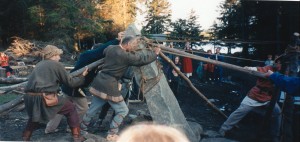
In the 1990s a rune stone was eretcted at Avaldsnes Viking Farm in memory of King Half, several hundred years after he was killed. The runes read: “Holmrygr raisti stain þan aft Halfr konungr” in Old Norse, which translates as “The rygr of the island raised this stone to the memory of King Halv.” The tribe here were called rygr (rugii) giving this region of Norway the name Rogaland. (Photo Marit Synnøve Vea)
I’ve been at sea
eighteen summers,
a bold boss I served,
stained shaft with blood.
Another lord
I’ll never find
more gallant in war,
nor grow old now.
So here Innstein
sinks to the ground,
lays himself down
by his leader’s head.
In latter times
at the telling of sagas,
they’ll hear of how
King Half died laughing. (Translation by Peter Tunstall)
Half is avenged
Rok the black and Utstein survived the battle and together with Half’s son Hjør, they went to avenge Åsmund’s betrayal of Half and his men. In the Historia rerum Norvegicarum, Tormod Torfæus tells the story as follows:
The following summer, Hjor, King Half’s son, summoned Solve, the King of Sweden, Half’s uncle, Hake, the King of Skåne, together with his son-in-law Rok, and Øystein, King of part of Denmark, followed by Utstein. With their armies, they sailed with an enormous fleet to Hordaland in order to avenge the murder of Half. It was easy to see how powerful Åsmund was, when so many powerful kings, led by Solve, had combined forces to fight him. And Åsmund was neither unprepared nor afraid, but did battle with them with great zeal and fought for a long time against the attack of these powerful kings.
We may reasonably believe that he was supported by allies, but in the end, the strongest and largest side had to win, and Åsmund was slain in battle.
Rok the black: the Viking and skald who tells the story of King Half
According to the saga, Rok and Utstein lived long lives as Vikings. Rok served under King Hake of Skåne, without anyone knowing who he really was. He was often mournful and had to swallow many patronising remarks from people who did not know who he was. Finally, Rok could stand it no longer and he told them that he was one of Half’s men.
Rok was also a skald and many of the verses that we believe he wrote are in the Saga of Half & His Heroes.
Half I saw hew
two-handed there,
no shield sheltered
our chief that day.
A worthier warrior
you wouldn’t find,
though hard you hunt,
or stouter-hearted. (Translation by Peter Tunstall)
While Rok resided at the court of Skåne, he fell in love with the king’s daughter, Brynhild, whom he married.
The family tree of King Augvald
|
Fornjot (Ymir) |
| Ægir – |
Kåre (Vind)- Loge |
|
Frost |
|
Snø |
|
Thorre |
| Gor – |
Nor – Goe |
|
Gard Agde |
|
Rugalf |
|
Rognvald |
|
Augvald(ca 600 e.Kr.?) |
|
Jøsur |
|
Hjør Jøsurson |
|
Hjørleiv den kvinnekjære |
|
Halv |
|
Hjør Halvson |
|
(Flein Hjørson) |
|
(Hjør Fleinson) |
|
Geirmund og Håmund Heljarskinn (Settlers in Island) |
Main photos/illustrations: Eva Gjerde, Historisk Museum, Bergen
Back

